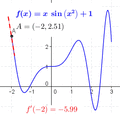Derivative facts for kids
A derivative is something new that comes from an original or existing thing. Think of it like a "spin-off" or a "version 2.0" of something that already exists! The word "derivative" can mean different things depending on what subject you're talking about. But the main idea is always about something being derived or coming from something else.
Where Do We Find Derivatives?
Derivatives pop up in many different areas of life and study. Let's explore some of them!
Derivatives in Language: How Words Grow
In linguistics, which is the study of language, a derivative is a word made from a more basic word. It's like building a new word by adding parts to an old one.
For example:
- The word "runner" is a derivative of the word "run." You add "-er" to "run" to make a new word.
- "Happiness" comes from "happy."
- "Unkind" comes from "kind."
This process helps us create many new words from a smaller set of basic words.
Derivatives in Chemistry: Making New Substances
In chemistry, a derivative is a substance very similar to an original substance. It has a small change in its chemical structure. Imagine you have a basic chemical molecule. You swap out just one or two tiny parts of it. The new substance you create is a derivative.
Even with a small change, the new derivative might have different properties or uses. It's like taking a basic building block and changing it slightly.
Derivatives in Finance: Understanding Financial Tools
A derivative in finance is a special type of financial agreement or "tool." Its value doesn't come from itself directly. Instead, it gets its value from something else. This "something else" is called an underlying asset.
It could be:
- The price of a stock (a small piece of ownership in a company)
- The price of a bond (a type of loan to a company or government)
- The value of a currency (like the US dollar or the Euro)
- The price of a commodity (like oil, gold, or corn)
Think of it like a contract whose value depends on how something else performs. For example, you might agree to buy oil in the future at a price decided today. The value of that agreement (the derivative) depends on the actual price of oil later. People use these tools to manage risk or make investments.
Derivatives in Math: Measuring Change and Speed
In mathematics, especially in calculus, a derivative is a very important idea. It helps us understand how things change. It measures the instant rate of change of something.
Imagine you're riding a bike:
- If you want your average speed, you divide total distance by total time.
- But what if you want your exact speed at one specific moment? Like right when you pass a certain lamppost? That's what a mathematical derivative helps you find! It tells you how fast something is changing at a precise point.
It's used in many fields. For example, figuring out how quickly a plant is growing. Or designing cars and predicting weather patterns.
Derivatives in Art: New Creations from Old Ideas
Derivative works are new creations made from an existing work of art. This is very common in creative fields! The new work "derives" or gets its inspiration from the original. It also takes some elements from it.
Examples include:
- A movie based on a popular book.
- A song that uses a "sample" (a small piece) from another song.
- A painting inspired by an older, famous painting.
- A fan fiction story based on characters from a TV show.
The new work builds upon the original. It adds new ideas or tells a new story. It still has a clear connection to its source.
Images for kids
Want to Learn More?
 In Spanish: Derivada para niños
In Spanish: Derivada para niños


